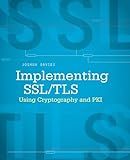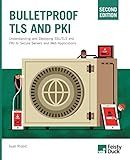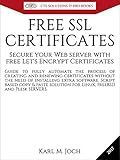Best Security Enhancements to Buy in December 2025

SSL/TLS Under Lock and Key: A Guide to Understanding SSL/TLS Cryptography



Implementing SSL / TLS Using Cryptography and PKI



Bulletproof TLS and PKI, Second Edition: Understanding and Deploying SSL/TLS and PKI to Secure Servers and Web Applications



FREE SSL CERTIFICATES: Secure your Web server with free Let's Encrypt Certificates Guide to fully automate the process of creating and renewing certificates. (CTS SOLUTIONS IT-PRO E-Books Book 4)



SSL server certificate creation manual for CentOS 8/7 (Japanese Edition)



My own Certificate Authority: Create your own graphical CA for Intranets with Open Source Software for Windows, Linux and MAC (CTS SOLUTIONS IT-PRO E-Books Book 1)



Mastering NGINX Second Edition



IIS Essentials: From Installation to Maintenance - The Ultimate Guide: Unleashing the Power of Your Web Server


To enable HTTPS in WordPress using .htaccess, you can add the following code to your .htaccess file:
RewriteEngine On RewriteCond %{HTTPS} off RewriteRule ^(.*)$ https://%{HTTP_HOST}%{REQUEST_URI} [L,R=301]
This code will redirect all non-HTTPS traffic to HTTPS. Make sure to backup your .htaccess file before making any changes, as incorrect edits can break your website.
What is the purpose of enabling https in WordPress?
Enabling HTTPS in WordPress is important for several reasons:
- Security: HTTPS encrypts data transmitted between the website and its users, ensuring that sensitive information such as login credentials, personal details, and payment information is protected from interception by hackers and malicious actors.
- Trust: A website with HTTPS is considered more trustworthy by users, as it indicates that the site is secure and takes their privacy and security seriously.
- SEO: Google gives preference to websites with HTTPS in its search rankings, so enabling HTTPS can improve the site's visibility and search engine ranking.
- Compliance: Many security standards and regulations (such as PCI DSS, GDPR, and HIPAA) require websites to use HTTPS to protect user data and comply with data protection laws.
Overall, enabling HTTPS in WordPress helps to enhance the security, trustworthiness, and SEO performance of the website, ultimately leading to a better user experience and increased success online.
How do I install an SSL certificate on a WordPress site?
To install an SSL certificate on a WordPress site, you can follow these steps:
- Purchase an SSL certificate: Choose a reputable SSL certificate provider and purchase an SSL certificate for your website.
- Generate a Certificate Signing Request (CSR): Log in to your web hosting account and generate a CSR. This is a file that contains your website's details and is used to generate the SSL certificate.
- Install the SSL certificate: Once you have received the SSL certificate from the provider, log in to your web hosting account and navigate to the SSL/TLS section. Upload the certificate file and install it on your website.
- Update your WordPress settings: Log in to your WordPress admin dashboard and go to Settings > General. Update the WordPress Address (URL) and Site Address (URL) fields to start with https:// instead of http:// to ensure that your website loads securely.
- Install a plugin (optional): If you want to further enhance the security of your website, you can install a security plugin like Really Simple SSL or WP Force SSL. These plugins automatically redirect your website to HTTPS and ensure that all resources are loaded securely.
- Test your SSL setup: Finally, test your SSL setup using an online SSL checker tool to make sure that your website is loading securely and that there are no errors with the SSL certificate installation.
By following these steps, you can successfully install an SSL certificate on your WordPress site and ensure that your website is secure for your visitors.
What is the difference between a self-signed certificate and a trusted SSL certificate?
A self-signed certificate is created and signed by the entity itself, without any third-party validation, while a trusted SSL certificate is issued by a trusted third-party Certificate Authority (CA) after verifying the identity of the certificate holder. Trusted SSL certificates are more secure as they are issued by a trusted entity and provide assurance that the website is legitimate and secure. Self-signed certificates do not provide this level of trust and may display a security warning in web browsers as they are not inherently trusted.
What are some plugins that can help with enabling https in WordPress?
- Really Simple SSL
- Let's Encrypt
- WP Force SSL
- Cloudflare Flexible SSL
- SSL Insecure Content Fixer
- Really Simple SSL
- WP Encrypt
- Cerber Security, Anti-spam & Malware Scan
How do I verify that my site is fully secured after enabling https?
There are a few ways to verify that your site is fully secured after enabling HTTPS:
- Check for the HTTPS padlock symbol in the address bar: When you visit your site in a web browser, look for a padlock symbol next to the URL. This indicates that your site is secured with HTTPS.
- Use online tools to check for SSL/TLS certificates: There are several online tools available that can help you check the SSL/TLS certificates installed on your site. Some popular tools include SSL Labs SSL Test, Qualys SSL Server Test, and SSL Checker.
- Check for mixed content warnings: When you enable HTTPS, all content on your site should be served over HTTPS as well. Check for any mixed content warnings in your browser's developer tools, as this can indicate potential security issues with your site.
- Set up HTTP Strict Transport Security (HSTS): HSTS is a security feature that ensures that your site is always accessed over HTTPS. By enabling HSTS, you can further enhance the security of your site and prevent downgrade attacks.
- Regularly monitor your site for security vulnerabilities: It's important to regularly scan your site for security vulnerabilities using tools like security scanners, vulnerability scanners, and web application firewalls to ensure that your site remains secure.
By following these steps, you can verify that your site is fully secured after enabling HTTPS and help protect your site and your users' data from potential security threats.
